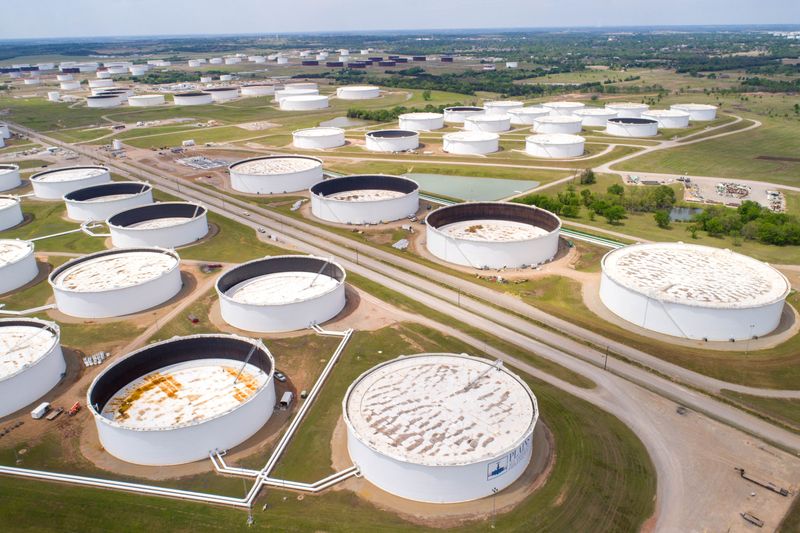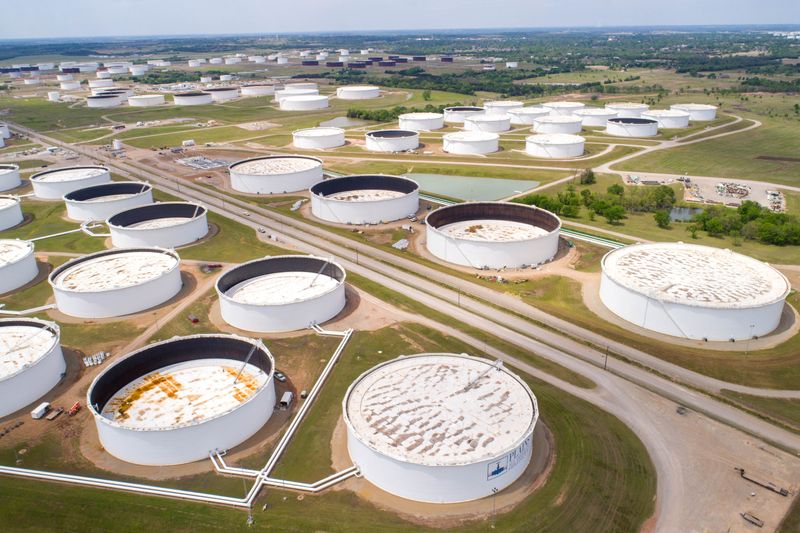Commodities
Oil surges nearly 6% after Israel begins ground raids into Gaza


© Reuters. FILE PHOTO: Crude oil storage tanks are seen in an aerial photograph at the Cushing oil hub in Cushing, Oklahoma, U.S. April 21, 2020. REUTERS/Drone Base/File Photo
By Stephanie Kelly
NEW YORK (Reuters) -Oil prices leapt nearly 6% on Friday, with posting its highest weekly gain since February, as investors priced in the possibility that the conflict in the Middle East could widen as Israel began ground raids inside the Gaza Strip.
Israel’s announcement marked a shift from an air war to ground operations to root out Hamas fighters a week after the militant Palestinian group’s deadly rampage in southern Israel.
Brent futures settled up $4.89, or 5.7%, at $90.89 per barrel. U.S. West Texas Intermediate (WTI) crude gained $4.78, or 5.8%, to $87.69 a barrel.
Both benchmarks posted their highest daily percentage gains since April.
Brent also recorded a weekly gain of 7.5%, its biggest such increase since February. WTI climbed 5.9% for the week.
The conflict in the Middle East has had little impact on global oil and gas supplies, and Israel is not a big producer. Investors and market observers, however, are assessing how it could escalate and what it might mean for supplies from nearby countries in the world’s top oil producing region.
Some residents in Gaza were abandoning their homes on Friday to escape from the path of an Israeli onslaught, after Israel ordered more than a million people to leave the northern half of the territory within 24 hours. Hamas told them not to go.
Iran’s Oil Minister Javad Owji said on Friday oil prices are expected to reach $100 per barrel due to the current situation in the Middle East, according to the ministry’s news agency SHANA.
Iran’s Foreign Minister Hossein Amirabdollahian on Friday discussed the Israeli-Hamas conflict with the head of the powerful Tehran-backed Lebanese armed group Hezbollah, which has launched its own cross-border attacks on Israel.
If the U.S. tightens enforcement of sanctions on Iran’s oil exports due to any role it may have in the conflict, then Iran’s oil supply could fall.
Saudi Arabia is putting U.S.-backed plans to normalize ties with Israel on ice, two sources familiar with Riyadh’s thinking said, signalling a rapid rethinking of its foreign policy priorities as the conflict escalates.
That may have implications for supply as Saudi Arabia told the White House it was willing to boost oil production early next year to help secure the deal, the Wall Street Journal reported last week.
Also boosting prices was the U.S. move on Thursday to impose the first sanctions on owners of tankers carrying Russian oil priced above the Group of Seven’s price cap of $60 a barrel, an effort to close loopholes in the mechanism designed to punish Moscow for its invasion of Ukraine.
Russia is the world’s second-largest oil producer and a major exporter, and the tighter U.S. scrutiny of its shipments could curtail supply.
“The oil market is anticipating that the U.S. will more strictly enforce sanctions on both Russia and Iran, and that will lead to a reduction in supplies,” said Andrew Lipow, president of Lipow Oil Associates.
The Organization of the Petroleum Exporting Countries (OPEC) this week kept its forecast for growth in global oil demand, citing signs of a resilient world economy so far this year and expected further demand gains in China, the world’s biggest oil importer.
On the U.S. supply front, drillers this week added four oil rigs in the biggest weekly rise since March, Baker Hughes said. [RIG/U]
Money managers cut their net long futures and options positions in the week to Oct. 10 by 39,556 contracts to 240,204 during the period, the U.S. Commodity Futures Trading Commission (CFTC) said.
Commodities
Oil prices rise; U.S. crude inventories plunge, Russia-Ukraine truce eyed
Commodities
India’s Reliance to stop buying Venezuelan oil over US tariffs, sources say
Commodities
Oil prices climb on Venezuela supply worries

 Forex3 years ago
Forex3 years agoForex Today: the dollar is gaining strength amid gloomy sentiment at the start of the Fed’s week

 Forex3 years ago
Forex3 years agoUnbiased review of Pocket Option broker

 Forex3 years ago
Forex3 years agoDollar to pound sterling exchange rate today: Pound plummeted to its lowest since 1985

 Forex3 years ago
Forex3 years agoHow is the Australian dollar doing today?

 Cryptocurrency3 years ago
Cryptocurrency3 years agoWhat happened in the crypto market – current events today

 World3 years ago
World3 years agoWhy are modern video games an art form?

 Commodities3 years ago
Commodities3 years agoCopper continues to fall in price on expectations of lower demand in China

 Economy3 years ago
Economy3 years agoCrude oil tankers double in price due to EU anti-Russian sanctions

































